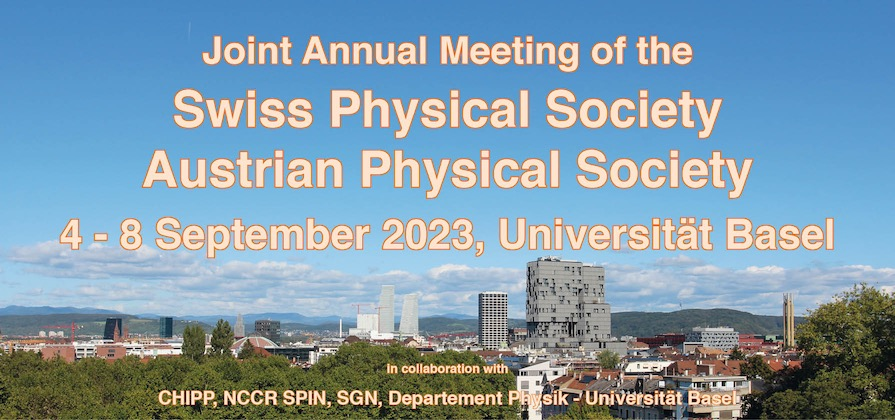The development of magnetic thin film multilayers that support skyrmions through interfacial Dzyloshinskii-Moriya interaction can benefit greatly from high-resolution magnetic imaging techniques, such as magnetic force microscopy. Achieving highest sensitivity in MFM imaging requires operating in vacuum using cantilevers with quality factors of up to 1 million. However, this requires new...
The coexistence of two skyrmion types in a single system is highly relevant for future racetrack memory devices using such solitons. Here, we demonstrate a metallic ferromagnetic/ferrimagnetic (FM/FI) bi-layer system in which two skyrmion types are successfully stabilized at room temperature. This system has a simpler structure compared to the previous demonstration of the same observation in...
The stray field of micro- and nanomagnets is exploited to manipulate the spin state of electrons confined in semiconductor quantum dots. Current devices use micromagnets that are uniformly magnetized along the direction of an external magnetic field. Here we introduce “U”-shaped Fe nanomagnets, where shape anisotropy sets a non-uniform magnetization pattern. We study the influence of size,...
We propose a scalable implementation of a quantum computer based on hardware-efficient mobile domain walls on magnetic racetracks. In our proposal, quantum information is encoded in the chirality of the spin structure of nanoscale domain walls. We estimate that these qubits are long-lived and could be operated at sweet spots reducing possible noise sources. Single-qubit gates are implemented...
Spin-orbit torque (SOT) has been intensively studied to realize energy efficient magnetization switching in spintronic devices. Recently, proposed orbital torque (OT) suggested that the large SOT can be generated even in weakly spin-orbit-coupled light metals by the orbital current. It is a consequence of the orbital Hall and/or orbital-Rashba effect and subsequent orbital-to-spin conversion...
The Rashba-type spin orbit coupling found at the interface of two dimensional electron gases (2DEGs) is of great interest for spintronic applications. Here, we uncover the nature of spin transport from a 2DEG to magnetic metal via second harmonic Hall measurements, spin-torque ferromagnetic resonance, and temperature-dependent ferromagnetic resonance (FMR). While FMR indicates enhanced spin...
Encoding information in antiferromagnetic (AFM) domains is a promising solution for the ever growing demand in magnetic storage capacity as the vanishingly small stray fields eliminate crosstalk between different domain states. However, the absence of macroscopic magnetization is detrimental to the manipulation and detection of AFM domains. We report evidence for a new AFM domain selection...
We study the structural, electronic, and magnetic properties of interfaces between two easy-axis antiferromagnets, Cr$_2$O$_3$ and $\alpha$-Fe$_2$O$_3$. Cr$_2$O$_3$ is the prototypical linear magnetoelectric, in which an applied magnetic field induces an electric polarization, whereas isostructural $\alpha$-Fe$_2$O$_3$ has a different antiferromagnetic ordering that does not allow a linear...
Technological advancements in the access to millikelvin temperatures allow first steps towards the investigation of individual magnons in the field of quantum magnonics [1]. Such experiments require millikelvin base temperatures, to ensure a thermal magnon-free system [2]. Here, we measured spin-wave transmission at temperatures below 45 mK in a yttrium-iron-garnet (YIG) film on a 500 µm-thick...
The design of a microstructure can affect the internal field distribution and, therefore, the spin-wave (SW) behaviour. Under the uniform excitation only symmetric SW interference pattern is expected. Changes in the geometry of the structure can cause breaking of the symmetry. In this work the asymmetry parameter (AP) of SW dynamics in confined rectangular permalloy microstrips is suggested...
To realise large-scale integrated magnonic circuits for quantum applications it is required to perform propagating spin-wave spectroscopy in nanostructures at low temperatures. In this work, we demonstrate all-electrical spin-wave propagation in a 100nm-thick yttrium-iron-garnet (YIG) film at temperatures down to 45mK. The extracted spin-wave group velocity and the YIG saturation magnetisation...
To facilitate magnonics technology, the delay time in nanostructures should be improved. Hence, single-crystalline sub-100 nm thick films of Ga:YIG and reference YIG were fabricated and characterised via VSM, FMR and BLS. Ga:YIG demonstrates a perpendicular magnetic anisotropy, reduced magnetisation, good Gilbert damping, and an enhanced exchange stiffness, which results in improved (~ 3.4...
It is known that YIG films on GGG substrates worsen their magnetic properties important for magnonics at low temperatures. We present experimental results, simulations, and an analytical theory to clarify the influence of the GGG substrate on a 97 nm-thick YIG film at ultralow temperatures. At low temperatures, the paramagnetic GGG substrate can be magnetized by an external magnetic field. The...
We use a bilayer of YIG/CoFeB to construct waveguides of the directional coupler to induce non-reciprocity in the spin-wave propagation and add new functionalities to the directional coupler. The non-reciprocity due to the symmetry breaking leads to $\Delta$k being different in the two propagation directions when magnetized in the Damon-Eschbach configuration $(+Δk≠-Δk)$. Therefore, the...
Manipulating spins and magnetic interactions for quantum computing encounters challenges due to invasive measurements. We employ spin-polarized scanning tunnelling microscopy (STM) to conduct electron paramagnetic resonance (EPR) experiment which probes magnetic interaction between spins delocalized into molecular orbitals of pentacene dimers. Spins in these organic molecules couple through...
Using symmetry analysis, first-principles density functional theory and spin dynamics, we pinpoint the origin of the diffuse neutron scattering observed in hexagonal yttrium manganite (h-YMnO$_3$). h-YMnO$_3$ is a prototype system for studying frustrated magnetism, due to its dominant first nearest-neighbor anti-ferromagnetic coupling on a triangular lattice. We argue that thermal fluctuations...
Functional materials, from catalysts to energy storage and load-bearing materials, are hierarchical polycrystalline composites. Their functionality derives from their composition, the 3D arrangement of components and their microstructure; the distribution of crystalline grains and the defects within them. Techniques providing this combination of information are currently either limited to...
We use soft x-ray magnetic laminography to characterize the three-dimensional spatial evolution of both the ferromagnetic and antiferromagnetic domains through the FeRh first-order phase transition. We observe different distributions of the nucleating magnetic domains in three-dimensions on heating and cooling. Monte Carlo simulations reveal different sample properties – namely, the sample...
